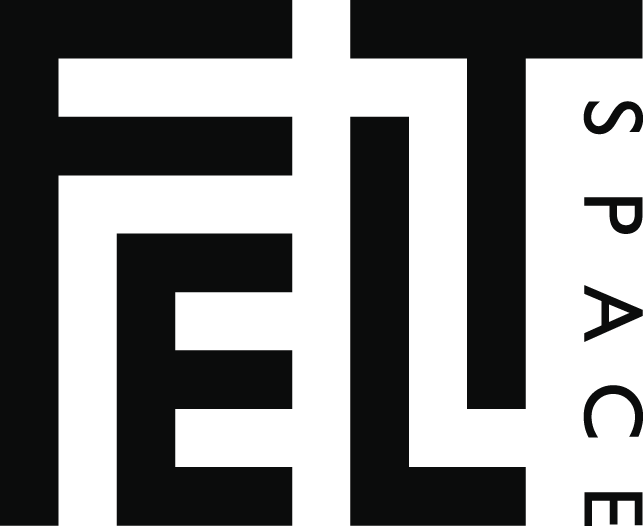LIGHTHOUSEKEEPING - SEPTEMBER 2015
Artists: Sally Arnold (SA), Rebecca Birch (UK), Mary Good (VIC), Elizabeth Hetzel (SA), Olga Sankey (SA)
Author – Lauren Mustillo
I am greeted by a soothing sound as I enter the FELTspace Front Gallery – a gentle, quiet crumpling. Four sets of hands on four screens are in the process of transforming a piece of paper - folding, crumpling, scrunching, un-crumpling, re-crumpling, re-folding – changing the paper from flat and crisp to supple and soft like fabric. Each pair of hands goes about this process in their own way. Some act methodically, folding the paper over itself inch my inch, whilst others are chaotic, squashing the paper tightly in a fist over and over again. These 10 minute works by Mary Good are played on constant loop and the repetitiveness of this ordinary action has a mesmerising and meditative quality. Echoing the cyclic patterns in nature I am reminded of waves crashing on a beach, or the softness of a cool summer breeze. Within the seemingly insignificant act of crumpling paper, are small rhythms enacting great change and transformation.
Exploring the transient and the transformative, Elizabeth Hetzel’s work explores our more subtle relationships with the environment. Projected onto the Front Gallery window, Hetzel’s video work, Storm painting, positions the viewer as a quiet spectator in the middle of a rain storm. Instead of capturing the turbulence and chaos of the moment, the work is silent and serene, imbued with an element of the sublime as the sun pierces through the dark grey clouds. The awe and beauty of the sun’s appearance speaks of chance encounters and unexpected moments – the all-encompassing power of nature as one of the last frontiers to defy human control. Hetzel described this work as a ‘collaboration with a storm’, a sentiment which serendipitously came to effect on the opening night as heavy rain poured down the window where the work was projected. The external world mirrored by the artwork, echoing our unpredictable relation with nature. Right place, right time.
On the back wall of the gallery, Sally Arnold’s painting explores the emotional through the geographic. The large work, Earth as a Lighthouse depicts a night time landscape, illuminated by a beacon of light. A sense of absence permeates this work, the emptiness of the landscape emphasises isolation and loneliness. Here, movement is implied, fostered by the knowledge that light from a lighthouse provides only a fleeting relief from the darkness. Arnold’s Looking for light series, a body of small works, hold more comfort. Each work is a study of the same single lightbulb, captured from a different angle or in different lighting. That such attention is given to an ordinary lightbulb has an element of tenderness. The works are placed on the gallery floor, propped up against the wall suggesting, perhaps, a domestic space and the way care for, and tend to, our safe places.
Olga Sankey has a unique relationship to the exhibition theme, drawn from her childhood experiences growing up as the daughter of a lighthouse keeper. At the exhibition opening Sankey explained that each lighthouse has its own unique flashing sequence, identifying it as an individual, telling a unique story. I imagine sea faring travellers finding comfort in the silent wave of the familiar beam of light. Through her works, the lighthouse is used as a signifier of warmth, comfort and safety, as seen in the diptych Futura Bold, which combines print techniques with sandblasted glass to inscribe the text ‘TAKE SHELTER’ across the surface. These layered print works emphasis the juxtaposition of light and dark. The words operate as both a reassuring offer of refuge, and a hasty warning, demanding an urgent call to action.
Moving to the Back Gallery, I am greeted by darkness. Rebecca Birch’s video work, Great Northern is projected in this space. The 45 minute single channel video captures conversations and encounters, drawn from daily life in the Arctic Circle, during the period of 24 hour darkness. The work is visually dark – a blank black screen is used between shots, and plain white text fades onto the screen prefacing scenes with narrative, transcribing conversations between artist and subject. Birch begins by describing her surroundings and the clothing she wears – fleece gloves, thick full length thermal underwear, fleece lined waterproof trousers – a signifier of the harsh coldness of the landscape. The banality of these descriptions is followed by a series of conversations between artist and subject, quickly developing a sense of foreboding. The dialogue centres upon the ominous and the uncanny. One resident describes his psychic prediction to ‘go south’ as a precautionary omen to leave, whilst another outlines the sheer danger of the place, saying ‘this land swallows up a lot of people’. Evident throughout this work is the capacity for people to be shaped by the harshness of their surroundings, and the resilience of the human spirit to find light in darkness.
The five artists use the personal and lived experience as fodder to explore what it means to move through spaces of light and dark, and the way we act and react in those spaces. Light has long been used as a metaphor for life. Lighthouse Keeping - to tend to light, to create safe passage and provide guidance, is to care for life. However, the success of Lighthousekeeping is not in its championing of light over dark, but the acknowledgment of both as equally necessary forces that act upon us and shape our internal and external landscapes.
